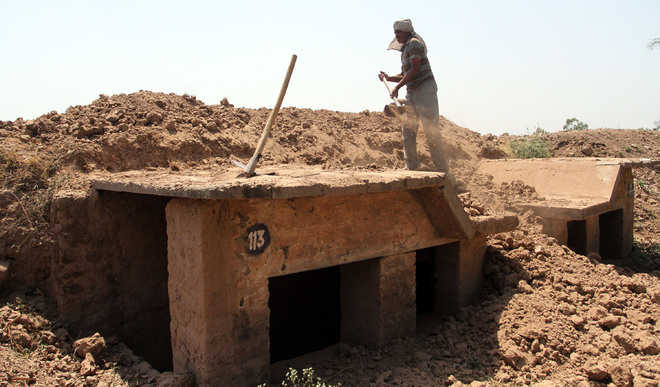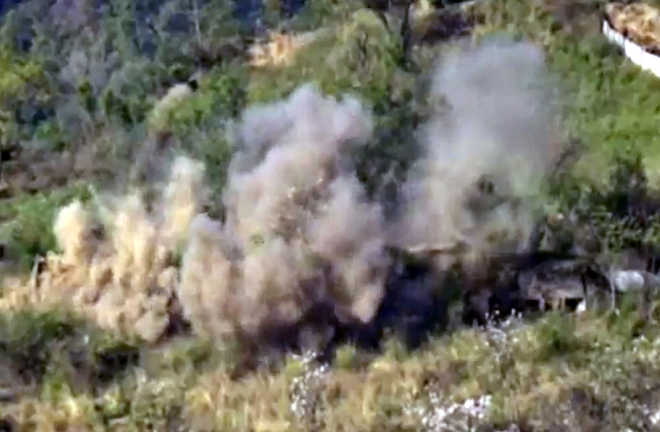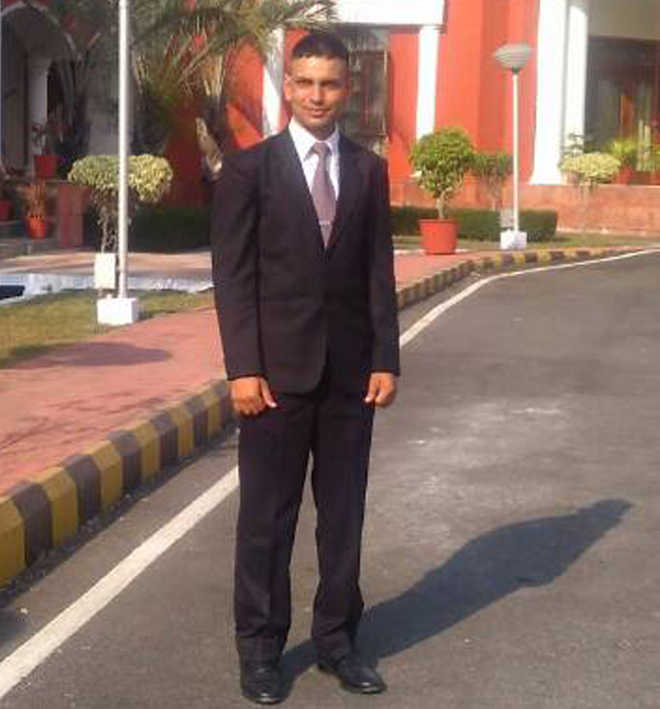During the 06 August 2013 flare up on the LC (LoC) in Poonch Sector and the beheading incident in January 2013 the common string of information was that the targeted killing of Indian jawans on the LC was executed by Border Action Teams (BATs). The same has happened again in Poonch sector’s Krishna Ghati (KG) area on 30 April 2017. Even in the Army, not many would boast of knowing what BATs are, how do they function (modus operandi), what effects they have and how the Indian Army handles the threat.
The public does question some things but there isn’t any information available for it to be better informed. My intention is to satiate that desire within precincts of security which will always remain the supreme consideration.
The world of the LC is the domain of just a few who have had the honor and the ‘high’ of serving in the razor sharp environment that presents itself daily in the ‘border areas’ of Jammu and Kashmir. It may be appropriate to clarify some of the basic ingredients of this high drama environment.
What is the LC?
The LC is different to the LAC (Line of Actual Control), quite different to the Actual Ground Position Line (AGPL) and much different to the Working Boundary (a term used only by Pakistan). The LAC alludes to the land boundary between the areas currently held by China and India along the northern borders. It is un-demarcated and both India and China have their different perceptions on its alignment, leading to frequent patrol clashes.
The AGPL refers to the un-demarcated area north east of NJ 9842, the point up to which the Suchetgarh Agreement had done the demarcation; it runs primarily along the Saltoro Ridge which prevents the Pakistan Army from even a glimpse on the Siachen Glacier. To detail these aspects would be to digress from the main issue and that is the LC. LC is quite often called LoC by the media but the Army prefers to shorten it to the more colloquial LC.
The LC is an imaginary line running along the current frontier between India and Pakistan in the state of Jammu & Kashmir. Although the Instrument of Accession of 26 August 1947 and Joint Resolution of the two Houses of Parliament in February 1994 place the entire area of Jammu and Kashmir with India, the ground situation changed over the last 65 years commencing with Pakistan’s invasion in 1947 the conflicts of 1965, 1971 and 1999 (Kargil), as also the proxy war launched by Pakistan since 1989.
The LC runs well towards east of the actual International Boundary (IB) and is the alignment along which the operations of 1947-48 came to a halt thus creating Pakistan Occupied Kashmir (PoK-often referred as Azad Kashmir, or AK, by Pakistan).
Unlike the International Border or IB which exists in Punjab, Rajasthan or Gujarat, there are no boundary pillars (BPs) delineating the LC, however, there are a series of mostly unrecognisable landmarks such as boulders, trees and nalas which have undergone change over years.
The Indian and Pakistan armies are in eyeball contact in their various pillboxes and piquets all along the alignment but at places terrain constraints may separate the two by two or more km.
The Jammu IB considered not in dispute by India is manned by the Border Security Force (BSF). The Indian Army is reinforcing some segments through depth and second tier deployment ever since the Samba and Kathua terror attacks in 2013.
The LC is the responsibility of the Army and this deployment is in tiers. Yet the BSF provides a few units to the Army for this deployment without which undeniably the Army will have manpower problems.
It is an environment little known to the outside world, where the notion of ‘Grabbers, Keepers’ exists. Translating this into reality it means that any side grabbing a piece of ground for a tactical advantage gets to keep it unless forcibly evicted (recall Kargil 1999).
Events Leading to Current Status
All was well on the LC till 1989 or so except the sporadic shootouts of lower intensity which took place for the sake of ‘moral ascendancy’. A much misunderstood term, ‘moral ascendancy’ remains even today a task for the wily infantrymen and encompasses a range of sub tasks primary being the sanctity of the LC, (no loss of ground) and prevention of rogue actions by Pakistan.
In 1989 things started to change drastically with the belief among the Kashmiri populace that ‘Azadi’ or merger with Pakistan was becoming a reality. The proxy war within the Valley had to be sustained by Pakistan through induction of terrorists, explosives, military hardware and finances. The LC became the obvious conduit through which all this happened.
Much against the common belief that the LC is manned meter to meter the ground reality is that there are large gaps dictated by terrain factors, logistics and climatic constraints. It is these gaps which were exploited and converted to ‘highways’ (a terrorist term) for movement of terrorists, potential terrorists (recruits), hardware, explosives and finances.
The Army was forced to re-deploy and selectively reinforce at the cost of its counter terrorist operational grid in the Valley floor. This left many of its LC piquets weaker as a new dimension was added to the task of ‘sanctity of the LC’ – this was Counter Infiltration.
Sensing a great opportunity the Pakistan Army commenced selectively targeting Indian piquets with a mix of regular troops and well trained terrorists (those who had undergone Daura-e-Khas training). The purpose – force back Indian Army counter infiltration ambushes, located between piquets and thus create the gaps needed for infiltration. Unprovoked firing by Pakistani posts further forced the creation of gaps. All this occurred in the nineties and progressive lessons learnt by the Pakistan Army refined the BAT concept.
Characteristics of BATs
BATs comprise a mix of Pakistan Army regulars, Pakistan Special Forces elements and high profile terrorists (Jihadis) who are trained to cross the LC to execute raids on Indian picquets, ambush and patrol parties or logistics elements. Strength of the team has mostly been 15 to 20 members.
Beheading has been one of the modus operandi adopted by these teams to cause fear and impose immense caution on their targets. The immediate effect of information about concentration of a BAT opposite a particular segment of the LC is an inevitable strengthening of the defensive stance; stronger patrols, more protection for logistics elements such as mule trains which carry advance winter stocking stores; all this at the cost of the counter infiltration grid. The situation can then be exploited for strong infiltration bids through gaps. Quite obviously BAT actions are in the mould of terrorist acts launched with the intent of imposing caution and creating the tactical conditions for terrorist infiltration.
The Coming of the LC Fence
The inevitable question – does the Indian Army sit on its haunches waiting to be attacked; far from it. Indian infantry units are known to have avenged ghastly acts by delivering telling blows on Pakistan Army and terrorists. In years before the Cease Fire came into place on 26 November 2003 exchange of Arty Fire and direct firing heavy weapons was common place.
Many an ingenious Indian gunner and infantry commander innovated and caused much destruction on the Pakistan Army.
Among others the name of Brigadier Jasbir Lidder (later Lieutenant General), Commander of the high profile 12 Infantry Brigade (Uri) is well known for his famous quip – “When Uri rumbles, Chakhoti (PoK town opposite Uri) crumbles”.
The ingenious LC fence constructed along the 16 and 15 Corps frontages under the outstanding leadership of then COAS Gen Nirmal Vij, in 2003-4 greatly altered the odds of infiltration.
This needs to be understood in the right perspective as the annual reconstruction of the fence (an expensive exercise in men and material) is very often questioned within the Army and the less informed bureaucratic circles.
The LC Fence
The LC Fence changed much more than just the awe inspiring landscape of the Pir Panjal and Shamshabari ranges. It altered what I call the ‘mathematics of terror’ in Jammu and Kashmir. Prior to 1 July 2004 (the date the fence officially came in existence) Pakistan successfully infiltrated 2,000 terrorists or more across the LC each year. On an average 1400-1500 were killed in engagements with the Indian Army on the LC or in the hinterland.
The residual figures were always in favour of Pakistan. Then came General Nirmal Vij who led the construction of the fence from the plains to the obscene heights of the Shamshabari, flaying the ‘nay sayers’. It altered everything.
The Indian Army now had an obstacle to concentrate upon and converted it from a mere line of barbed wire to a system comprising steel, lead, electronics, ether and human beings.
By 2006 the Indian Army had acquired the knowledge and experience of exploiting the LC fence which was leaking just a few hundred terrorists annually while the Army eliminated double the number in its operations. The mathematics were now reversed leading to the situation in 2011-12 when less than 300 terrorists roamed the Valley and 19 top terrorists leaders were eliminated with focused counter terrorism operations. Only 42 terrorists could enter the Valley, as confirmed by the Multi Agency Centre (MAC) The transformational ‘Heart Doctrine’ combined with this approach almost brought Kashmir to the doorstep of conflict stabilisation awaiting conflict resolution.
The media and the public have often questioned how BATs can enter 400 – 500 meters into our side and conduct an operation. There is a simple answer to this.
In 2003-04 when the LC fence was constructed there was no ceasefire for most of the period; hence the fence had to be constructed well away from the LC at most places.
Where ever we were or are in domination the construction was well forward, hugging the LC. The fence gives natural protection against rogue actions but where it is aligned well inside we per force have picquets/posts/detachments ahead but not necessarily on the LC as long as the area ahead can be dominated by fire.
Small patrols are used to dominate this space and these are the patrols which are vulnerable to BAT actions. If you do not patrol and acquire a defensive mindset you are open to ceding that piece of territory to Pakistan. BATs can therefore enter minefields with considerable risk but no other obstacle prevents them from accessing the Indian Army’s patrol bases or routes of patrolling near (400-500 metres) the LC.
To expect Pakistan Army to use BATs more extensively after the Indian Army’s successful handling of the situation in J&K is to state the obvious. We often hear of the phrase ‘keeping the pot boiling’ in Kashmir while Pakistan handles the Afghan border and its internal security threats.
The elimination of Burhan Wani in 2016 became a trigger for Pakistan to extend full support after it sensed an opportunity. While street turbulence is the chief modus operandi and local terrorists are ruling the roost, Pakistan has to establish its own significance, contribute to the movement and also control it.
To execute this concept Pakistan requires its terrorist foot soldiers (boots on the ground) in J&K; to allow the fast dwindling strength to reduce even further would be a catastrophe for the ISI’s post 2016 strategy in J&K. Thus the necessity, to once again force creation of gaps on the LC, to facilitate infiltration.
Many veterans of the Army would recall some of the well-known BAT actions which were launched against Indian Army units and the counter actions taken by the same units. The Indian Army has foiled many BAT actions than the ones which have succeeded. In 2012, 16 Punjab foiled a major action in the Tangdhar Sector.
Handling BATs at Different Levels
In my long years handling the LC from sub unit to a Corps Commander I always found the threats from BATs as the most challenging, relished countering these and taking the battle into Pakistan’s territory. Here is an example.
In 2008, a Pakistan Army unit decided to send a 15 man officer led team across the LC to dislodge a small detachment of my brave Rajputs who had temporarily occupied a patrol base to dominate an area of the LC not visited or patrolled for long; I observed this during a visit and had directed that the area be dominated. In the ensuing clash between four young Rajput soldiers without a senior leader and the 15 Pakistanis the Rajputs lost one soldier and killed 7 Pakistanis.
All hell broke loose by day on the LC in a frontage of about 3 to 4km. The CO was adamant about crossing the LC and razing a post from where the Pakistani soldiers had come.
My orders to the CO were crystal clear – “The night is yours, I do not want the Pakistani bases, from where the soldiers had emerged, to remain standing but you will not cross the LC. You have all other means to do so.” The Rajputs shocked me next morning when they reported the destruction caused to the Pakistan Army posts, confirmed through photographs and video clips. The last hurrah was when a Pakistan Army helicopter emerged late the next afternoon and took away the Pakistani Brigade Commander; it was later learnt that he was removed from command; so much for the moral ascendancy achieved by the Rajputs.
As the General Officer Commanding of the division I asked no one and no one advised me. It was my calling and the risk was also mine. However, to give the leadership its due, not one superior commander asked any questions.
The above example displays just how Pakistan Army’s proactive and provocative stance on the LC needs to be handled. The offensive response by Indian Army units has to be reflected in their attitude from the moment they step into the designated area of responsibility. Most BAT actions take place during handing/taking over between units when command and control is supposedly loose.
Infantry units do not realise that each action of theirs even before they arrive in their AOR, is under surveillance. Many units having fearsome reputation will never be tested; others with lesser credentials and poor body language of their troops would get tested early. The first engagement if handled with professional aggression will allow a unit a tenure with little turbulence. Destiny has brought many units of both Armies from the Kargil war once again face to face on the LC.
The reader must not go away with the impression that the Pakistan Army and terrorists rule the roost on the LC, far from it. Yet, it is imperative that our commanders be bold, trust their instinct, train their troops hard and war game contingencies regularly. This is 24×7 soldiering where every movement has to be controlled and reactions kept ready; most important of all – time is the worst enemy of effectiveness on the LC.
As a sector cools down so does the vigil and then one fine day it happens; there is only one solution to this – constant reminders to all at the oddest time of the day or night. The most awkward aspect of my command style was the calls I would give to subordinate officers down to young captains. These were almost always late at night so that it became a one to one private chat.
Never was any negative sentiment conveyed, always a positive word. Just a few tips on protection of the patrols and logistics parties, strengthening of the forward picquets and ensuring that an administrative attitude never entered into troops, were spoken about. The effect was that the young officer went back to his CO, who went back to his Brigade Commander, who then sent the reminder down to the last man.
It was reverse communication and sometimes this works far better. There is no rest on the LC and no room for not innovating; those who rest bodies or minds seldom live to tell the tales which at the LC are aplenty. I know 22 Sikh, the unit which suffered the recent BAT action and I know when you challenge it, this kind of a unit cannot take an insult.
That it will give it back after keeping the enemy on tenterhooks for some time, is inevitable.
This article has been adapted and updated from the write up by the author in South Asia Defence and Strategic Review published in October 2013.



























































































































